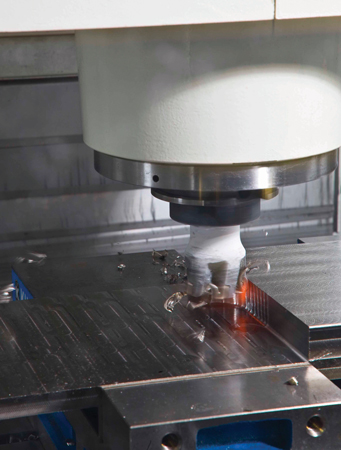MAG’s groundbreaking low-flow cryogenic titanium machining process has been approved by the government for use in production of the Lockheed Martin F-35 Lightning II stealth fighter. According to Lockheed Martin, when broadly applied this new technology could improve affordability and efficiency in the production of the F-35, which is approximately 25 percent titanium. MAG demonstrated the process at the imX show in Las Vegas, machining a complete titanium component representative of both commercial and military aerostructure parts. Senior Lockheed Martin personnel were also at the show to discuss the unique process and its integration into the supply chain.
Cryogenic titanium machining increases cutting-tool life up to a factor of 10 and doubles the material-removal rate, compared to conventional machining methods in certain applications.  The multi-patented process using liquid nitrogen (-321°F) was developed over a period of years by the team of Creare Incorporated, H.M. Dunn Company, and MAG IAS working with Lockheed Martin, the U.S. Navy Small Business Innovation Research (SBIR) Program Office, and the F-35 Joint Program Office (JPO) with funding provided by SBIR program awards. According to Mike Packer, vice president of Manufacturing Strategy & Technical Integration at Lockheed Martin Aeronautics, “This is a prime example of an SBIR-developed technology transitioning from the research and development phase to a system that can enhance affordability for near-term military projects like the F-35.”
The multi-patented process using liquid nitrogen (-321°F) was developed over a period of years by the team of Creare Incorporated, H.M. Dunn Company, and MAG IAS working with Lockheed Martin, the U.S. Navy Small Business Innovation Research (SBIR) Program Office, and the F-35 Joint Program Office (JPO) with funding provided by SBIR program awards. According to Mike Packer, vice president of Manufacturing Strategy & Technical Integration at Lockheed Martin Aeronautics, “This is a prime example of an SBIR-developed technology transitioning from the research and development phase to a system that can enhance affordability for near-term military projects like the F-35.”
MAG IAS, the largest U.S.-based manufacturer of machine tools, is commercializing the process under exclusive license. Its machine tools are already used by the worldwide aerospace industry for the production of virtually all aircraft. The company also provides a unique portfolio of CYCLO CUT® cutting tools, CYCLO COOL® metalworking fluids, composites processing systems, and support services devoted to aerospace manufacturing.
“This is one of the greatest breakthroughs in the history of metalworking, and it promises to rewrite the book on machining speeds and costs for difficult to machine materials, which are critical in aerospace, and coming into common use in automotive and general industry applications as well,” says Michael Judge, vice president of Cryogenic Business Development. “In addition to the increases it brings in metal removal rates and tool life, low-flow cryogenic machining is a green manufacturing process that will produce a cascade of additional cost reductions by eliminating, or vastly minimizing, the use of liquid coolants. Liquid nitrogen is a non-greenhouse gas, so it is harmless to the environment, too.”
MAG is offering cryogenic tool cooling technology on a range of new machines, including five-axis and turning systems, as well as providing retrofit systems. For more information please visit [www.mag-ias.com].


















